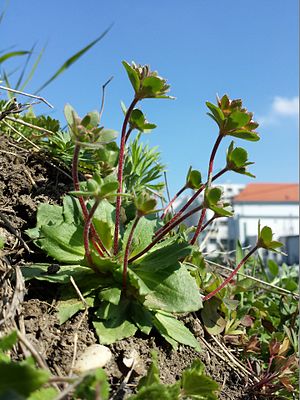Acker man sign
| Acker man sign | ||||||||||||
|---|---|---|---|---|---|---|---|---|---|---|---|---|

Acker-Mannsschild ( Androsace maxima ) |
||||||||||||
| Systematics | ||||||||||||
|
||||||||||||
| Scientific name | ||||||||||||
| Androsace maxima | ||||||||||||
| L. |
The field man's shield ( Androsace maxima ), also known as the giant cup man ’s shield , giant man’s shield , large man’s shield and chalice man’s shield , is a species of plant in the primrose family (Primulaceae).
description
Vegetative characteristics
The Acker-Mannsschild grows as an annual , herbaceous plant and reaches a height of 3 to 15 centimeters. It has no non-flowering rosettes . All leaves are arranged at the base , the blades undivided.
Generative characteristics
The flowering period begins partly in March and lasts until April. The umbellate inflorescence is multi-flowered and sits on a stem covered with simple hairs . The bracts resemble the foliage leaves and are the same length or longer than the flower stalk.
The hermaphroditic flowers are radial symmetry and five-fold with a double flower envelope . The white, sometimes pink-colored corollas have five short, yellow scales in their throat, which usually become reddish when they fade. The corolla tube is narrowed towards the throat, the corolla lobes have a length of 1 to 5 millimeters and are a little shorter or significantly longer than the crown tube. The flowers are not styled differently.
The number of chromosomes is 2n = 20 to 80.
ecology
The Acker-Mannsschild is a therophyte .
distribution
The Acker-Mannsschild occurs in southern , central and eastern Europe and otherwise in Asia and North and West Africa . It occurs rarely to very rarely in Central Europe . In the German-speaking area, it is at home in Austria and Switzerland . In Austria the Acker-Mannsschild rarely occurs only in the Pannonian area of the federal states Vienna , Lower Austria and Burgenland . In Austria the Acker-Mannsschild is considered to be threatened with extinction.
The Acker-Mannsschild thrives on stony, gaps in grain fields, vineyards, embankments, railway embankments and dry ruderal areas of the colline to submontane altitude . The Acker-Mannsschild is a character species of the association Caucalidion lappulae in Central Europe , but also occurs in Eastern Europe in the association Alysso-Sedion.
Systematics
Androsace maxima was first published in 1753 by Carl von Linné .
There are subspecies depending on the author:
- Androsace maxima L. subsp. maxima
- Androsace maxima subsp. turczaninovii (Freyn) Fed. (Syn .: Androsace turczaninowii Freyn ): It occurs in Russia, Belarus, Ukraine and Moldova.
Individual evidence
- ↑ a b Erich Oberdorfer : Plant-sociological excursion flora for Germany and neighboring areas . With the collaboration of Angelika Schwabe and Theo Müller. 8th, heavily revised and expanded edition. Eugen Ulmer, Stuttgart (Hohenheim) 2001, ISBN 3-8001-3131-5 , pp. 739-740 .
- ↑ a b c Qiming Hu, Sylvia Kelso: Primulaceae. : Androsace maxima , p. 80 - online with the same text as the printed work , Wu Zheng-yi & Peter H. Raven (eds.): Flora of China , Volume 15 - Myrsinaceae through Loganiaceae , Science Press and Missouri Botanical Garden Press, Beijing and St Louis, 1996. ISBN 0-915279-37-1 .
- ↑ a b c d Karol Marhold, 2011: Primulaceae. : Datasheet Androsace maxima In: Euro + Med Plantbase - the information resource for Euro-Mediterranean plant diversity. Berlin 2011.
literature
- Manfred A. Fischer, Karl Oswald, Wolfgang Adler: Excursion flora for Austria, Liechtenstein and South Tyrol . 3rd, improved edition. Province of Upper Austria, Biology Center of the Upper Austrian State Museums, Linz 2008, ISBN 978-3-85474-187-9 , p. 683 .
Web links
- Androsace maxima L., giant man's shield. In: FloraWeb.de.
- Acker man sign . In: BiolFlor, the database of biological-ecological characteristics of the flora of Germany.
- Androsace maxima L. In: Info Flora , the national data and information center for Swiss flora . Retrieved January 16, 2016.
- Thomas Meyer: Mannsschild data sheet with identification key and photos at Flora-de: Flora von Deutschland (old name of the website: Flowers in Swabia .)
- Entry in Botanik im Bild / Flora von Österreich , 2008.



